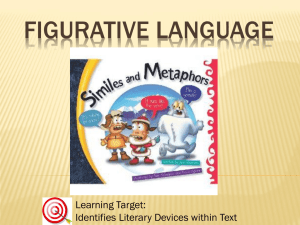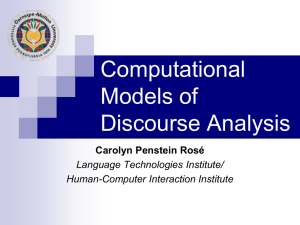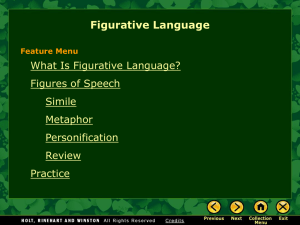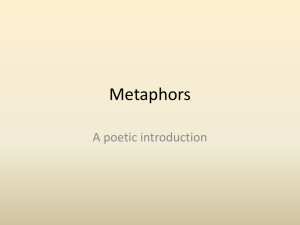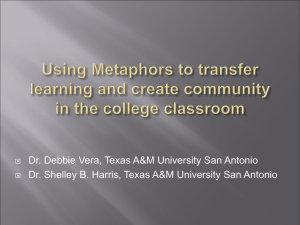Chapter02
advertisement
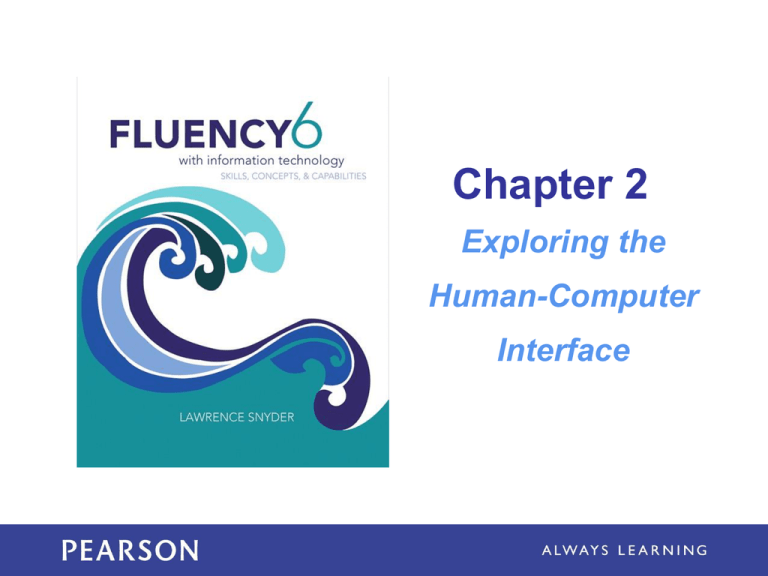
Chapter 2 Exploring the Human-Computer Interface Learning Objectives • Give names to computing features that you know intuitively • Explain placeholders and the placeholder technique • Explain how “metaphor” is used in computing • Describe the desktop metaphor, giving examples of appropriate icons • Describe the touch metaphor, giving sample motions • Explain how the desktop and touch metaphors differ Feedback • A computer assists us, doing whatever we ask it to do • We want our “assistant” to report on the progress of the task it is doing • We need to know that the task was done and when to give another one • Computer systems always give the user feedback about what is happening Feedback • Feedback is an indication that either the computer is still working or it is done • Feedback takes many forms: – The revision is visible – Areas on the screen become highlighted, shaded, gray, underlined, color change, or you might hear a click Feedback • Most common form of feedback is that the computer is performing a time-consuming operation – Cursor is replaced by a different icon – Some apps give custom feedback – Or use a progress bar to give an estimate on time remaining – Always expect feedback Consistent Interface • Regardless of who makes the software, icons and menus tend to be similar – Especially so within a specific company (Microsoft for example) – Look for similar menu names, like File and Edit – Look for similar functions within the menus, like Cut, Copy, Paste in the Edit menu Consistent Interface • Why? 1. Companies reuse the same code in each of their applications 2. Aids you in learning and using additional applications 3. Certain operations are so fundamental to processing that all apps just use those oprations New Instance • Under File you usually find a command, New – New creates a “blank” instance of the kind of files the application creates – What is “blank information”? • An empty structure to hold (record) all of the properties of that file and store its content • Example: A new/empty address book entry is ready to hold names, images, and phone numbers about the new individual New Instance for the Address Book Clicking and Blazing • Consistency provides a strong sense of familiarity with a new application • With a new app, two important activities are immediately performed: – “Clicking Around” to explore the application to see what features are available – “Blazing Away” is trying the application in a way you haven’t done so before Perfect Reproduction • Computers encode information as a sequence of binary digits, 0’s and 1’s • Because of the use of two digits, we call it digital information • Using only 0’s and 1’s means that digital information can be perfectly reproduced or replicated 10010111 10101100 11001010 Exact Duplicate • A second copy is made simply by duplicating the sequence of 0’s and 1’s • This is one way digital improves on analog information – Analog information comes from or is stored on a continuously variable medium – A copy of an image, for example, could come out too dark or too light when compared to the original The Perfect Reproduction Property of Digital Information • It also doesn’t matter where the copy came from: – Both the original and the copy are the same sequence of 1’s and 0’s – Every copy can be made from the last copy, and still be identical to the original! Copying • Copy/Paste/Edit – Copy and Paste operations are available in many applications – When editing a file, you can either create content from “scratch” or use Copy/Paste (C/P) to reproduce it from another location – Copy/Paste is generally faster and less error prone How We Learn Technology • Find and ReplaceAll – In Find/Replace editing operations, the source content to Find is identified in the document – The target content to Replace it with is also identified – Find/ReplaceAll (F/RA) is an all-at-once version of Copy/Paste • Use an abbreviation of a long name or title as a placeholder, then use F/RA to put in the correct name all at once! Placeholder Technique • For many the purpose or operation of a new technology may seem obvious • Some technologies require instruction (driving a car or using a chain saw!) • Much of the technology we use we figure out on our own – We know intuitively what to do – The technology developers did that on purpose! Metaphors • In computing, a metaphor is an icon or image used as representative or symbolic of a computation • When designers create a technology, they use metaphors to help users know how to operate their devices without reading a manual • Metaphors are a terrific solution! The Desktop • In the ‘70s the first personal computer (the Alto) was developed • It was the first computer with a Graphic User Interface when the computer booted • Since the computer was designed for business use, the metaphor that was used for the screen was desktop – Other business metaphors: files, folder, documents The Desktop The Desktop • Steve Jobs and Steve Wozniak founded Apple and built computers without GUIs • Jobs saw the Alto and liked the GUI concept • Apple redesigned an unsuccessful personal machine (Lisa), then launched the Mac in 1984 • Soon after, Microsoft began developing Windows to replace its DOS system More Computer Metaphors • The Mac first introduced the mouse to the public…another component in desktop metaphor – Apple did not invent it – Stanford Research Institute invented the mouse in December 1968 – When introduced, it was stated that they called it a mouse and didn’t know why they didn’t change the name! Changing Metaphors • A new idea, the touch metaphor – Users touch the content, smart phones, tablets, and other mobile devices – Example: the Cover Flow mechanism for scanning through a list, using a sweeping motion of the pointer Touch Metaphor Gestures Metaphor Relationships • The touch metaphor is intended to simplify the use of smart phone and tablets • This technology is not new (use of stylus and touch screen interaction at kiosks) • Touch has no mouse • It’s possible to use the touch metaphor with a trackpad or mouse so it is not limited to mobile devices Why is Touch a Metaphor? • It’s a way to eliminate the mouse, but… • It changes how humans interact with the computer – Scrollbars using the desktop metaphor for moving through a display – Small screens don’t have room for scrollbars – Direction of motion is opposite between touch and desktop metaphors Why is Touch a Metaphor? • It changes how humans interact with the computer – With the touch metaphor, your hands are “on” the content – You move the content to where you want it to be – With the desktop metaphor you “slide a window over the content” Summary of Metaphors • We use technical metaphors daily – They are 100 percent synthetic, created by imagination of the developers – They are meant to simplify the use of the devices. • The touch metaphor will not replace the desktop metaphor • Both have extensively determined how we think and behave with technology Summary • We can figure out software because designers use consistent interfaces, suggestive metaphors, and standard functionality • We should explore a new application by “clicking around” and “blazing away” • Making exact copies is a fundamental property of digital information that we use daily Summary • Find and ReplaceAll are standard operations that simplify our computer use • Metaphors are essential to computer usage because the guide us in learning and using software • The desktop metaphor is classic; the touch metaphor is newer; they will co-exist


